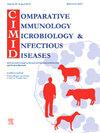中国南方广州城市地区野生啮齿类动物的流行病学和博卡病毒的遗传多样性。
IF 2
3区 农林科学
Q4 IMMUNOLOGY
Comparative Immunology Microbiology and Infectious Diseases
Pub Date : 2024-10-01
DOI:10.1016/j.cimid.2024.102244
引用次数: 0
摘要
Bocaparvovirus 属的成员对人类健康有重大影响,可感染多种宿主,增加了跨越物种障碍的可能性。在各种哺乳动物宿主中,啮齿类动物被广泛认为是新病毒和人畜共患病病毒的重要贮藏地。然而,尽管最近有啮齿类动物感染博卡病毒的报道,但我们目前对大鼠博卡病毒(RBoV)遗传多样性和进化的了解还很有限。本研究收集了中国南方广州市城区的啮齿动物样本,以调查 RBoV 的存在和遗传多样性。通过对 296 份啮齿动物脾脏进行 PCR 筛选,54 份样本被确定为 RBoV 感染阳性,并获得了 12 个几乎完整的 RBoV 基因组序列。系统发生学分析表明,RBoV 有不同的系和亚系,并确定了 6 个具有较强统计支持的重组事件,其中 5 个事件涉及本研究获得的序列。这些结果突显了广州市啮齿类动物中流行的RBoV的遗传多样性,并强调了广泛监测以更好地了解RBoV流行病学、进化特征和跨物种传播潜力的重要性。本文章由计算机程序翻译,如有差异,请以英文原文为准。
Epidemiology and genetic diversity of bocavirus in wild rodents in urban areas of Guangzhou, Southern China
Members of the genus Bocaparvovirus have a significant impact on human health and can infect a wide range of hosts, increasing the likelihood of crossing species barriers. Among the various mammalian hosts, rodents are widely recognized as important reservoirs for emerging and zoonotic viruses. However, despite recent reports of bocavirus infections in rodents, our current understanding of rat bocavirus (RBoV) genetic diversity and evolution is limited. In this study, rodent samples were collected from the urban areas of Guangzhou city, Southern China, to investigate the presence and genetic diversity of RBoV. Through PCR-based screening of 296 rodent spleens, 54 samples were determined to be positive for RBoV infection, and 12 nearly complete genome sequences of RBoV were recovered. Phylogenetic analysis revealed distinct lineages and sub-lineages of RBoV, and six recombination events with strong statistical support were identified, with five of these events involving sequences obtained from this study. These results highlight the genetic diversity of RBoV circulating in rodents in Guangzhou city and emphasize the importance of extensive surveillance to gain a better understanding of RBoV epidemiology, evolutionary characteristics, and potential for cross-species transmission.
求助全文
通过发布文献求助,成功后即可免费获取论文全文。
去求助
来源期刊
CiteScore
4.60
自引率
0.00%
发文量
102
审稿时长
40 days
期刊介绍:
Comparative Immunology, Microbiology & Infectious Diseases aims to respond to the concept of "One Medicine" and to provide a venue for scientific exchange. Based on the concept of "Comparative Medicine" interdisciplinary cooperation between specialists in human and animal medicine is of mutual interest and benefit. Therefore, there is need to combine the respective interest of physicians, veterinarians and other health professionals for comparative studies relevant to either human or animal medicine .
The journal is open to subjects of common interest related to the immunology, immunopathology, microbiology, parasitology and epidemiology of human and animal infectious diseases, especially zoonotic infections, and animal models of human infectious diseases. The role of environmental factors in disease emergence is emphasized. CIMID is mainly focusing on applied veterinary and human medicine rather than on fundamental experimental research.

 求助内容:
求助内容: 应助结果提醒方式:
应助结果提醒方式:


